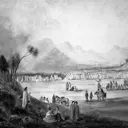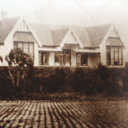Tuku Rākau
Located in the land between Greenaway Road and Puriri Road. There is currently no public access to this site.
This area was the centre for Te Āti Awa at Waikanae from about 1849 until 1886, when its people moved to a site near the new railway.
Tuku Rākau established
1848
Led by their chief, Wiremu Kingi Te Rangitake, over 600 Te Ati Awa people from the Kapiti area returned to their ancestral lands of Taranaki. The villages that they left behind were damaged by the 1848 earthquake and by sand encroachment.
1849–86
With government encouragement, most of the remaining Te Āti Awa moved to Tuku Rākau, a sheltered and fertile area just north of Kaiwarehou, a crossing point on the Waikanae River. Led by Wi Tako Ngatata-i-te-Rangi, they established homes, gardens, and a meeting house, Puku Mahi Tamariki.
The intention of the meeting house was to provide an assembly house for Kingitanga. In 1877, a church was built at Tuku Rākau. Wheat was ground at a flour mill on the Waimeha Stream and large flocks of sheep were established. The urupa (burial ground), Takamore, is on the sand ridge west of this site.
Wi Parata was a substantial landowner on Kāpiti Island and the mainland. He represented Western Māori in parliament, 1871–77. The large kauri tree west of this plaque grew beside his house.
1873
The Native Land Court awarded the 29,500 acre Ngarara Block to a section of Te Āti Awa, who retained it as communal tribal land.
Moving to the railway
1881
The Crown bought 15,500 acres of steep country in the Tararua foothills to give to the Wellington and Manawatu Railway Company in part payment for building the railway.
1884
At a meeting on the Tuku Rākau marae, railway company officials met local Māori who agreed to give land for the development of the railway on condition that all trains stopped at Waikanae. When the line opened for traffic (1886) the meetinghouse, Whakarongotai, was brought to its present site in Marae Lane.
1891
The Native Land Court split the Ngarara Block between individual Māori owners, who were then free to sell their property.
1895
A bullock team dragged the church from Tuku Rākau to Elizabeth Street in the township then known as Parata, where it now forms the core of St. Luke’s church.
1906
After Wi Parata’s death, much of the Māori-owned land west of the railway line was sold. In 1911 the Greenaway family settled here and farmed for several generations.
1961
Waikanae Christian Holiday Park Inc. (El Rancho) purchased land from the Weggery family who had farmed the area for over 20 years. An extensive indoor and outdoor holiday complex now operates here.
 The house built by L H Greenaway near the corner of Puriri and Kauri Streets, Waikanae, 1917. The cost of the building was 1,100 pounds on 19 December 1913. It was built of heart rimu with 12-foot studs. FH Greenaway Collection, Alexander Turnbull Library
The house built by L H Greenaway near the corner of Puriri and Kauri Streets, Waikanae, 1917. The cost of the building was 1,100 pounds on 19 December 1913. It was built of heart rimu with 12-foot studs. FH Greenaway Collection, Alexander Turnbull Library


